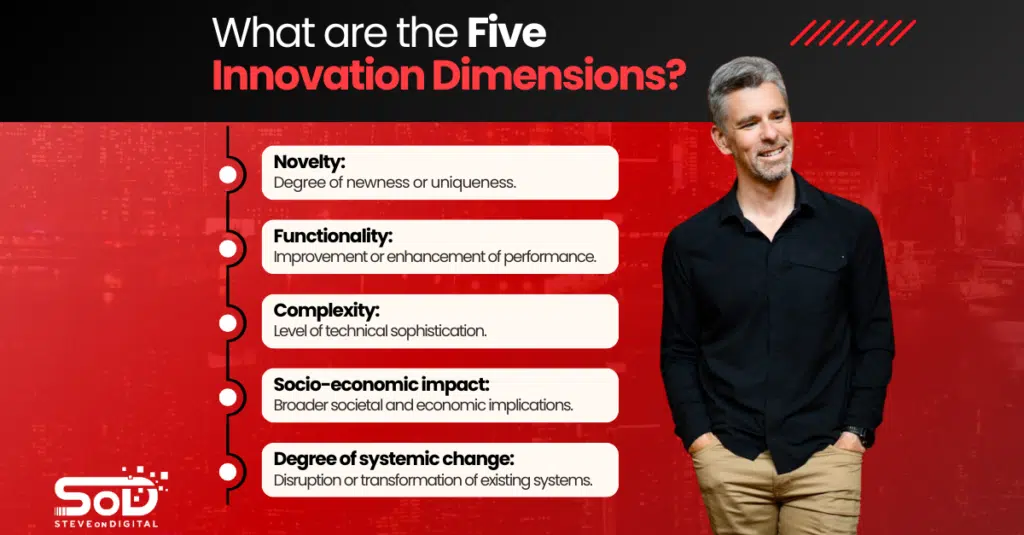What Are The Five Innovation Dimensions? – SteveOnDigital

In today’s fast-paced world, innovation isn’t just a buzzword; it’s the backbone of any successful business, especially for small and medium-sized enterprises (SMEs). Hi, I’m Steve Johnston from SteveOnDigital, and having navigated the digital transformation landscape through both calm and turbulent waters, I’ve witnessed firsthand the power and necessity of innovation. With a background in electrical engineering, an MBA, and a master’s in Project Management, I’ve dedicated my career to demystifying digital technology for SMEs. It’s not just about keeping up; it’s about leading the way. Grasping the key dimensions of innovation—product innovation, process innovation, business model innovation, network innovation, and brand innovation—is essential for businesses aiming to maintain a competitive edge. This understanding is pivotal for successful innovation, ensuring that companies can navigate through the evolving demands of the marketplace and technological landscape. It’s not just about introducing a new product or tweaking your marketing strategy; it’s about a holistic approach to transforming your business model, processes, and even the culture within your organization. This guide aims to shed light on what these dimensions of innovation are and why they’re vital for SMEs striving to make a mark in the digital era. Understanding Innovation Dimensions Definition Of Innovation Innovation, at its core, is about introducing something new. But it’s not just any new thing; it’s about bringing forth ideas, products, or methods that add value – value for your business, your customers, and your stakeholders. It’s the engine that drives progress, efficiency, and differentiation in a crowded market. Overview Of The Five Innovation Dimensions Innovation is multi-faceted; it’s not a one-size-fits-all concept. It spans across: Significance Of Each Dimension In The Current Business And Technological Landscape In the digital age, these dimensions of innovation are more relevant than ever. Digital technology not only enables but also accelerates innovation across all these dimensions. For SMEs, understanding and implementing these dimensions can mean the difference between leading the pack and playing catch-up. Each of these dimensions offers a unique lever for growth and competitive advantage. By understanding and applying them, SMEs can navigate the complexities of the digital marketplace with greater confidence and success. Overview of the Five Innovation Dimensions Dimension Description Product Innovation Involves developing new products or significantly improving existing ones to meet emerging customer needs or tap into new markets. Process Innovation Focuses on enhancing or developing new processes to improve efficiency, reduce costs, or improve quality, thus offering additional value to customers. Business Model Innovation Changes how a business creates, delivers, and captures value, often through the adoption of new technologies and strategies. Network Innovation Revolves around the formation of strategic partnerships and collaborations to fuel innovation and expand market reach. Brand Innovation Entails the evolution of a brand’s image, voice, and customer experience to enhance perception and drive loyalty. Dimension 1: Product Innovation Innovation is the heart of growth and sustainability, especially in the digital age we’re navigating today. As Steve Johnston from SteveOnDigital, I’ve seen firsthand how innovation can transform businesses, particularly through product innovation. This dimension of innovation focuses on developing new products or significantly improving existing ones. It’s about meeting emerging needs or tapping into new markets, a process often fueled by digital technology and artificial intelligence (AI). Digital technology and AI have revolutionized product innovation, enabling businesses to create smarter, more efficient, and more user-friendly products. From AI-driven analytics tools that predict customer behavior to IoT devices that revolutionize home security, technology is at the forefront of new product development. One standout example is the evolution of smartwatches, which have transcended their initial utility to become indispensable health and communication tools. For SMEs, the opportunity to leverage product innovation is immense. Concentrating on niche markets or distinct customer challenges, SMEs can leverage their innovative business models and specialized capabilities to surpass larger industrial incumbent firms. This strategic focus on target customers, combined with the application of disruptive innovations and digital technology, enables smaller enterprises to achieve successful innovations and carve out a competitive advantage in their sectors. A practical approach is to integrate AI to personalize offerings or use cloud-based platforms to speed up the development process, making innovation both accessible and cost-effective. Dimension 2: Process Innovation While product innovation captures the spotlight, process innovation is the unsung hero that enhances efficiency, reduces costs, and improves quality. It involves rethinking the ways in which products or services are created and delivered. In my experience, integrating digital transformation strategies into operational processes has been a game-changer for SMEs. The impact of digital transformation on operational processes cannot be overstated. Automation and cloud computing, for example, streamline operations, freeing up valuable resources and reducing errors. During my tenure with SteveOnDigital, I’ve witnessed SMEs achieve remarkable efficiency gains by adopting tools like workflow automation software and project management platforms, leading to significant cost savings and improved customer satisfaction. Case studies across various industries highlight the transformative potential of process innovation. A local bakery, for example, might implement an inventory management system powered by AI to predict stock levels and reduce waste, while a manufacturing firm could use 3D printing to produce parts on-demand, slashing lead times and inventory costs. The key for SMEs is to identify bottlenecks in their current processes and explore digital solutions that can address these challenges. This often requires a mindset shift, viewing technology not as an expense but as an investment in future profitability. Dimension 3: Business Model Innovation Business model innovation is perhaps the most profound dimension of innovation, as it reimagines the very foundation on which businesses operate. This approach involves changing how a company creates, delivers, and captures value. In the digital era, innovative business models have disrupted industries, from streaming services upending traditional media to ride-sharing apps challenging conventional taxi services. Digital technology plays a pivotal role in the innovation of business models, introducing transformative concepts such as platforms, subscriptions, and freemium models. These innovative business models leverage technology to create additional value for target customers, showcasing the power of business model innovation in today’s

